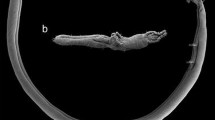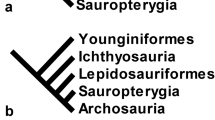Summary
The crustacean class Mystacocarida is restricted to the interstitial marine sand environment. A cinemicrographic analysis of the functional morphology of locomotion in the mystacocarid D. typica was undertaken to demonstrate how this species progresses through the interstitial spaces. Locomotion is completely dependent on the presence of dorsal and ventral substrates. The biramous second antennae and mandibles are the force-generating appendages. During a locomotory cycle, the exopods of the second antennae and mandibles are directed dorsolaterally against a dorsal substrate. This creates a downward force enabling the endopods to gain purchase on the ventral substrate. The second antennae and mandibles undergo coordinated cyclic movements. Each cycle results in two power and two recovery strokes. The animals undergo approximately 4 complete cycles per second. The calculated maximum rate of locomotion is 420 μm/s. The measured rate under test conditions is 250 μm/s. A turning-escape reaction in response to air bubbles and other factors results in a 180° turn in a confined space within 1.5 s. These data are discussed in relation to the morphological conservatism of mystacocarids, their presumed neotenic origin and their observed migration over a tidal cycle. It is proposed that all crawling interstitial animals will have developed specific mechanisms to increase frictional forces between their locomotory appendages and the surrounding substrate.
Similar content being viewed by others
References
Baccari S, Renaud-Mornant J (1974) Anatomie du tube digestif de Derocheilocaris remanei Delamare et Chappuis, 1951 (Crustacé, Mystacocaride). Arch Zool Exp Gen 115:607–620
Cals P, Delamare Deboutteville C, Renaud-Mornant J (1968) Nature et adaptations à un mode de vie en milieu interstitiel des structures cuticulaires céphaliques chez Derocheilocaris remanei Delamare Deboutteville et Chappuis (Crustacea-Mystacocarida). C R Acad Sci Paris D 266:126–129
Dahl E (1952) Mystacocarida. Reports of the Lund University Chile Expedition 1948–49. Lunds Univ Arrskrift 48:1–41
Delamare Deboutteville C (1953) Recherches sur l'écologie et la répartition du mystacocaride, Derocheilocaris remanei Delamare et Chappuis en Méditérranée. Vie Milieu 4:459–469
Delamare Deboutteville C (1960) Biologie des Eaux souterraines littorales et continentales. Hermann, Paris, p 740
Gurney R (1942) Larvae of decapod Crustacea. Ray Soc, London, p 306
Hall JR (1972) Aspects of the biology of Derocheilocaris typica (Crustacea: Mystacocarida). II. Distribution. Mar Biol 12:42–52
Hessler RR (1964) The Cephalocarida-Comparative skeletomusculature. Mem Conn Acad Art Sci 16:1–97
Hessler RR (1969a) A new species of Mystacocarida from Maine. Vie Milieu 20:105–116
Hessler RR (1969b) Mystacocarida. In: Moore RC (ed) Treatise on Invertebrate Paleontology. Part R Arthropoda 4:192–195
Hessler RR (1972) New species of Mystacocarida from Africa. Crustaceana 22:259–273
Hessler RR, Sanders HL (1966) Derocheilocaris typicus Pennak & Zinn (Mystacocarida) revisited. Crustaceana 11:141–155
Hessler RR, Newman WA (1975) A trilobitomorph origin for the Crustacea. Fossils Strata 4:437–459
McIntyre AD (1969) Ecology of marine meiobenthos. Biol Rev 44:245–290
Pennak RW, Zinn DJ (1943) Mystacocarida, a new order of Crustacea from intertidal beaches in Massachusetts and Connecticut. Smithsonian Misc Coll 103:1–11
Remane A (1933) Verteilung und Organisation der benthonischen Mikrofauna der Kieler Bucht. Wiss Meeresunters Abt Kiel 21:161–221
Remane A (1952) Die Besiedelung des Sandbodens im Meere und die Bedeutung der Lebensformtypen für die Ökologie. Zool Anz (Suppl) 16:327–359
Renaud-Mornant J (1976) Un nouveau genre de crustacé Mystacocaride de la zone néotropicale: Ctenocheilocaris claudiae n.g., n.sp. C R Acad Sc Paris D 282:863–866
Renaud-Mornant J, Delamare Deboutteville C (1976) L'originalite de la sous-classe des mystacocarides (Crustacea) et le problème de leur répartition. Ann Spéléol 31:75–83
Riedl RM, Machan R (1972) Hydrodynamic patterns in lotic intertidal sands and their bioclimatological implications. Mar Biol 13:179–209
Rieger RM (1977) The relationship of character variability and morphological complexity in copulatory structures of Turbellaria-Macrostomida and -Haplopharyngida. Mikrofauna Meeresboden 61:197–216
Rieger RM, Ruppert EE (1978) Resin embedments of quantitative meiofauna samples for ecological and structural studies — Description and application. Mar Biol 46:223–235
Ruppert EE (1977) Zoogeography and speciation in marine Gastrotricha. Mikrofauna Meeresboden 61:231–251
Swedmark B (1964) The interstitial fauna of marine sand. Biol Rev 39:1–42
Westheide W (1977) The geographical distribution of interstitial polychaetes. Mikrofauna Meeresboden 61:287–302
Author information
Authors and Affiliations
Additional information
This investigation was supported in part by a National Science Foundation grant # DEB-7823395 to E. Ruppert. Contribution # 442 of the Belle W. Baruch Institute for Marine and Coastal Research
Rights and permissions
About this article
Cite this article
Lombardi, J., Ruppert, E.E. Functional morphology of locomotion in Derocheilocaris typica (Crustacea, Mystacocarida). Zoomorphology 100, 1–10 (1982). https://doi.org/10.1007/BF00312196
Received:
Issue Date:
DOI: https://doi.org/10.1007/BF00312196




